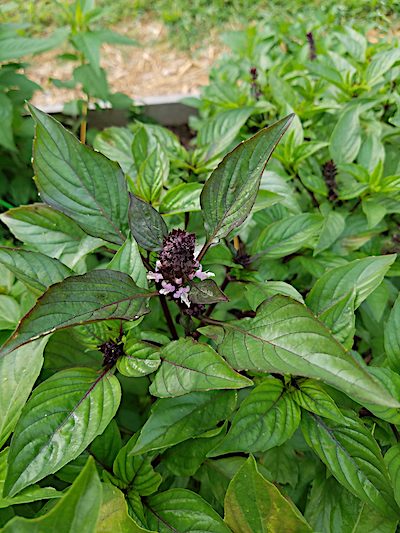International Gardener
Herbs — Asian Style
By Pat Dickey, Fairfax Master Gardener
This is the next part of our series on international gardening. This time the focus is on herbs. They are available at local Asian or international markets, but wouldn’t it be nice if you could pick fresh herbs from your own garden or windowsill?
 Lemongrass
Lemongrass
This delightful citrusy plant, Cymbopogon citratus, is a native of southern India and Sri Lanka. It is a grayish-green grass that you can grow by rooting stalks that you purchase at the international market. Seeds are also available, but they need to be started indoors as transplants. Lemongrass is used to flavor Asian cooking, such as curries, soups and fish dishes, or steeped in boiling water for tea. It can also be infused into essential oil.
To root the stalks, first trim a couple of inches off the top and peel away anything that looks dead or brown. Place the stalks in a glass with a little water and place it in a sunny window. After a few weeks, you will begin to see roots. Once the roots become larger, plant the lemongrass in a pot with rich potting mix and place it back in the sun. If you begin the lemongrass from seeds, plant them in a container early in the spring.
After all danger of frost, you can bring your lemongrass outside. You can either position your pot in a sunny location or plant the lemongrass in your garden with rich loamy soil and good drainage. Keep your lemongrass on the moist side, but don’t overwater it. It will grow up to 4 feet tall and wide. Lemongrass is not winter hardy in our area, so even though it is a tender perennial, it will die after frost temperatures in the fall. Before that happens, you can pick some of the rooted stalks from your garden, removing the leaves, and repot them to bring back inside for the winter.
When harvesting your lemongrass, cut away the long grassy stems. Press the remaining tiny bulbs at the end of the stems with a knife, much like garlic, to add to recipes. Or, the tough stems can be used like a bay leaf by adding them to soup or tea and then removing them before serving.
 Vietnamese Coriander
Vietnamese Coriander
Originally from Southeast Asia, Persicaria odorata is another popular herb used in Asian cooking. It is known as Vietnamese coriander or Vietnamese or Asian mint, although it is not from the mint family. Another popular local name is rau ram. You can use the young leaves raw in salads or as a garnish, or they can be cooked in Vietnamese rice dishes, vegetable soups, stews, noodle dishes and stir fry recipes.
Vietnamese coriander has bright green leaves that are long and pointed on purple stems, with dark markings on the upper surfaces. The leaves have a coriander-like smell and taste slightly hot and spicy. This herb grows in full sun, but prefers partial shade, and thrives in a moist area. It also requires good air circulation. Even though it is a perennial, it is not winter hardy in Zone 7. Plant it outside in your garden or container after all danger of frost. This type of coriander is sold as plants, but you can also purchase cuttings at an Asian market and root them in a glass of water much like lemongrass.
This herb will be ready to harvest two months after planting. The plant tips will show roots and will form colonies. Vietnamese coriander has rapid growth and may need to be divided during the season.
 Thai Basil
Thai Basil
This unique basil, Ocimum basilicum var. thyrsiflora, has the flavor of licorice or anise and is slightly spicy. Its origin is most likely from Thailand or southeast Asia. It is added to food dishes from Thailand, Vietnam, Laos and Cambodia. You can use it in chicken, pork or beef recipes, curries or add it to pho, a Vietnamese soup. It will also flavor vinegar and be steeped for tea. Thai basil can also be used as an ornamental plant in the landscape.
The leaves are sage green on purple stems and shaped like spearheads. Thai basil prefers a sunny location and rich, well-drained but moist soil. It is also a perennial but is grown here as an annual, since it is not winter hardy. It has purple flowers and grows 12 to 18 inches high. Start your seeds indoors four weeks before the last frost or direct sow them in the garden after all danger of frost. Lightly cover seeds and space groups of three or four seeds 12 inches apart, thinning them to one plant when it has four leaves.
Harvest your basil after 10 weeks. Start from the top by pinching the new branches and removing the flowers, so that the plant will grow bushier. Morning harvests are best for peak flavor. Thai basil will grow back if heavily picked. It is suggested that you fertilize your basil with fish emulsion or a seaweed solution as directed on the container. When watering, keep the water away from the leaves and direct it toward the roots; otherwise the basil will turn yellow.
Another note: While researching for this article, I discovered that shiso (Perilla frustescens), that is also used in Asian cooking, is on Virginia’s invasive plant list. It is also called beefsteak plant or perilla. It is currently rated as a low invasive, so it is not recommended that you plant it in your garden.
References
Finding Asian Herbs and Vegetables for Your Garden, Andrea Nguyen, Viet World Kitchen
Lemon Grass, Herb Gardening, University of Illinois Extension
Persicaria odorata, Missouri Botanical Garden
Sweet Thai Basil, Southern Exposure Seed Exchange